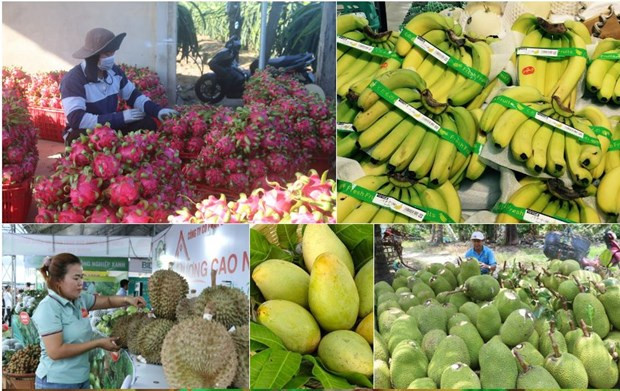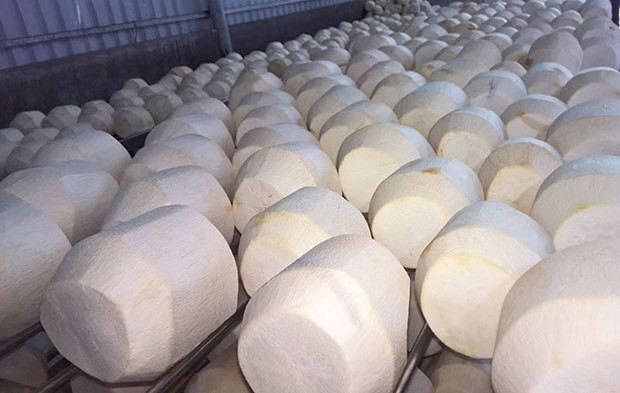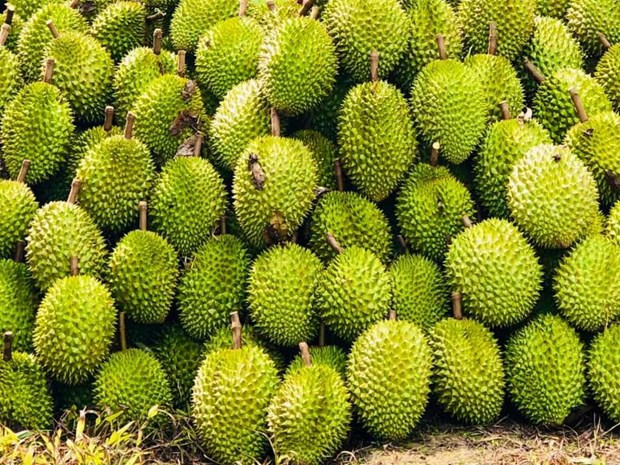 A variety of Vietnam’s farm produce has been exported to China and the US via official channels. (Photo: VietnamPlus)
A variety of Vietnam’s farm produce has been exported to China and the US via official channels. (Photo: VietnamPlus)Hanoi (VNA) – The signing of agreements and protocols on the export of farm produce to other countries has opened up opportunities to multiply the export value of these products, creating a stable income for farmers. However, it is even more challenging to maintain a foothold in foreign markets.
Opportunities from official export
The Animal and Plant Health Inspection Service (APHIS) under the US Department of Agriculture has informed Vietnam of the decision to allow Vietnam’s husked coconuts to enter the US immediately. The sole phytosanitary conditions for shipments will be enforced exclusively at US points of entry.
This is the eighth fruit from Vietnam to gain access to the US market, following mango, longan, lychee, dragon fruit, rambutan, star apple and pomelo.
In September, coconut is expected to be added to the list of Vietnamese fruit allowed to be exported through official channels to China.
With access to those two markets, Vietnam now has the opportunity to raise the export value of coconut and transform it into a major currency earner.
 With access to the US and Chinese markets, coconut now has the opportunity to become a major currency earner (Photo: VietnamPlus)
With access to the US and Chinese markets, coconut now has the opportunity to become a major currency earner (Photo: VietnamPlus)According to Dang Phuc Nguyen, General Secretary of the Vietnam Vegetable and Fruit Association, Vietnam’s coconuts are preferred in many markets thanks to sweeter and whiter milk than those from other countries. However, when China tightened control over imports through unofficial channels in 2019, coconut products from Vietnam were not included in the list of fruit eligible for official import. The US also changed its rule, so Vietnam’s fresh coconut could not enter this market. As a consequence, the price of fresh coconut on the domestic market plummeted, affecting the livelihoods of many farmers.
The re-opening of those major purchasing markets is good news for coconut farmers.
Challenges in maintaining market foothold
Along with the good news, coconut exports now face the main issue of how to maintain market access, just like the story of durian.
In 2022, durian gained permission to enter China through official channels, and the export value of the fruit surged. In the first six months of this year, durian brought home 876 million USD, up nearly 19 times from 44.2 million USD posted in the same period last year.
It is a long and complicated process to get permission to access foreign markets. The negotiation process may last up to 10 years, for example talks on the export of lychee to Australia took 11 years and mango to the US 10 years. The importing country has many requirements for the fruit, from phytosanitary, packaging to cultivation, harvest procedures, and location certification.
However, the challenges do not stop after gaining permission. There have been lessons in this regard, such as the suspension of mango export to Japan last year or the recent warning of China against durian and dragon fruit from some coded growing areas due to violations of phytosanitary rules.
 In the first six months of this year, durian brought home 876 million USD, up nearly 19 times from 44.2 million USD posted in the same period last year (Photo: VietnamPlus)
In the first six months of this year, durian brought home 876 million USD, up nearly 19 times from 44.2 million USD posted in the same period last year (Photo: VietnamPlus)The Ministry of Agriculture and Rural Development (MARD) has suspended the export of fruit from violating areas to investigate the cause and decide measures to handle the problems.
The ministry stressed that such violations could lead to importers imposing stricter measures or even suspending the import of one kind or even all farm produce from Vietnam.
MARD is continuing to work on market issues to facilitate the export of farm produce and to optimise existing free trade agreements. The ministry also coordinates with firms to acquire trademarks and geographical certifications for local products with export potential with a view to expanding export markets./.





























